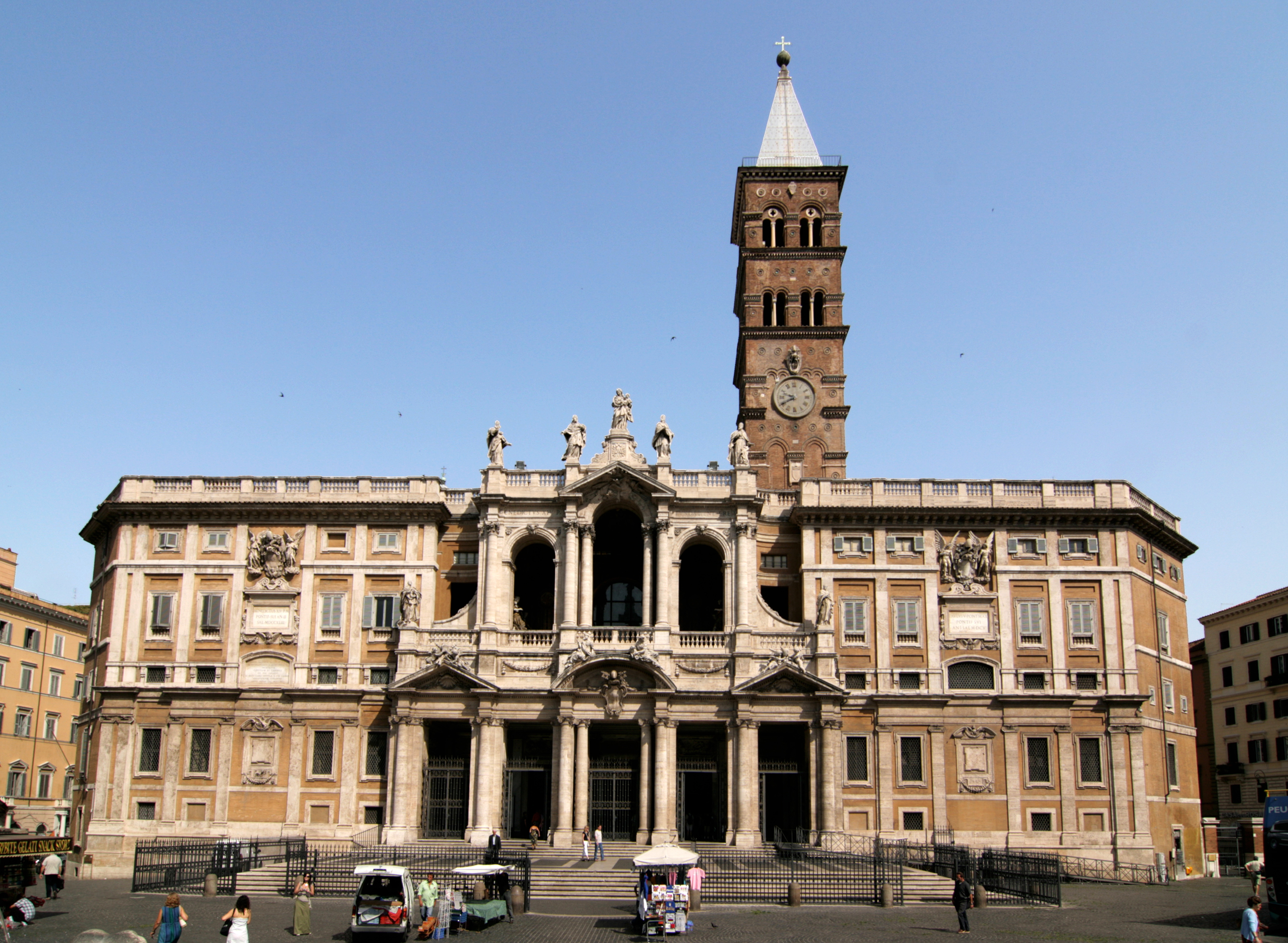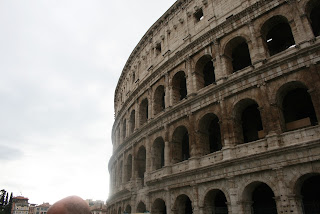Saturday - November Fourth Two Thousand Seventeen
After all of the rushing and bustling to get our entire room packed up into suitcases and bags, we managed to make it to the train station in time to meet the group. We had to take a train from Prato P.S. to Firenze S.M.N. (Florence Santa Maria Novella) which is the main train hub for Florence and then take a train from there to Roma Termini station. We got to our hotel at around 1:15 but we had to wait in the lobby because our rooms weren't ready yet. Jeunesse, Laura (our Rome roommate), and I finally got our key and headed upstairs. We were the only ones to get the same room number, 301, that we have at Hotel Giardino in Prato. Thinking that we were going to have some time to rest and get settled, we put our bags down and sprawled on the beds. It seemed that we were too quick to jump in because we then got word that we needed to be back downstairs by 2 pm to go on a tour.

We honestly didn't think that we would be walking for that long, so we ran downstairs and started our trek. This tour consisted of the church of Santa Maria Maggiore, the Trevi Fountain, the Spanish Square, and the Spanish Steps. The two most important are:


We honestly didn't think that we would be walking for that long, so we ran downstairs and started our trek. This tour consisted of the church of Santa Maria Maggiore, the Trevi Fountain, the Spanish Square, and the Spanish Steps. The two most important are:

SANTA MARIA MAGGIORE- This church was about a 2 minute walk from our hotel, Hotel Gioberti, in Rome. It has a very Baroque style. There is a 5 foot railing that goes around the perimeter of the church that signifies the jurisdiction of the Holy See (an independent sovereign entity overseen by the Pope and Vatican City). Once you cross the threshold you are no longer in Italy. The creator of the church is Gian Lorenzo Bernini who was really a jack of all trades that everyone loved. The church is known for bearing the fragments of the manger that baby Jesus laid in and for the remains of Bernini. The Santa Maria Maggiore was built from a miracle. A priest had a vision of God saying to build a church. When the priest asked "Where?" God responded by saying I will send you a sign. In the first week of a hot August that year it snowed a great deal but only on the lot that the church now stands today.
 TREVI FOUNTAIN- This famous fountain resides on the back of the Poli family palace and was designed by the architect named Nicola Salvi. It's made of travertine marble that comes fro a city 22 miles east of Rome. The story of the actual sculpture itself is "the taming of waters," which is portrayed by 5 separate characters. The man in the center under the triumphal arch is Neptune/Poseidon. The two men in front of him are Tritons taming the seahorses that represent the sea and nature. There are also two women carved into the wall on either side of Neptune. These women are named Salubrity and Abundance which represent that the water in Rome is abundant and clean to drink. The relief sculpture on the top of the wall depicts the chronological history of how the Ancient Roman aqueduct was founded and how it was renovated to now supply the Trevi Fountain.The throwing of the coin is a very old tradition and it has to be done by taking your right hand and throwing it over your left shoulder backwards.
TREVI FOUNTAIN- This famous fountain resides on the back of the Poli family palace and was designed by the architect named Nicola Salvi. It's made of travertine marble that comes fro a city 22 miles east of Rome. The story of the actual sculpture itself is "the taming of waters," which is portrayed by 5 separate characters. The man in the center under the triumphal arch is Neptune/Poseidon. The two men in front of him are Tritons taming the seahorses that represent the sea and nature. There are also two women carved into the wall on either side of Neptune. These women are named Salubrity and Abundance which represent that the water in Rome is abundant and clean to drink. The relief sculpture on the top of the wall depicts the chronological history of how the Ancient Roman aqueduct was founded and how it was renovated to now supply the Trevi Fountain.The throwing of the coin is a very old tradition and it has to be done by taking your right hand and throwing it over your left shoulder backwards.
Sunday - November Fifth Two Thousand Seventeen
Our second day was spent touring and walking from 10 am to 1 pm. Most of the walk was spent walking past important things in Rome and slowing down to let people catch up or running to catch up with Silvia's pace. The biggest tour attraction/let down was the Colosseum.We loved hearing the history about it but we also expected to go inside which did not happen.
 THE COLOSSEUM- This fantastic piece of architecture used to be a large lake. The name Colosseum is believed to have come from a colossal statue that stood in front of it. The statue is no longer there because it was melted down and used for other things after that empire. It was built in the first century under the Roman emperors of the Flavian dynasty. Construction of the building itself started in 72 AD. Inside the Colosseum there were all kinds of events happening. Criminals had to fight wild animals. Under Domitian, dramas were also held in the Colosseum but with a bloodthirsty realism such as using real prisoners for executions. A real Hercules was burned on a funeral pyre and in the role of Laureolus a prisoner was actually crucified. The Colosseums's actual name is the Flavian Amphitheater which means double theater instead of being a semi circle.
THE COLOSSEUM- This fantastic piece of architecture used to be a large lake. The name Colosseum is believed to have come from a colossal statue that stood in front of it. The statue is no longer there because it was melted down and used for other things after that empire. It was built in the first century under the Roman emperors of the Flavian dynasty. Construction of the building itself started in 72 AD. Inside the Colosseum there were all kinds of events happening. Criminals had to fight wild animals. Under Domitian, dramas were also held in the Colosseum but with a bloodthirsty realism such as using real prisoners for executions. A real Hercules was burned on a funeral pyre and in the role of Laureolus a prisoner was actually crucified. The Colosseums's actual name is the Flavian Amphitheater which means double theater instead of being a semi circle.
 THE COLOSSEUM- This fantastic piece of architecture used to be a large lake. The name Colosseum is believed to have come from a colossal statue that stood in front of it. The statue is no longer there because it was melted down and used for other things after that empire. It was built in the first century under the Roman emperors of the Flavian dynasty. Construction of the building itself started in 72 AD. Inside the Colosseum there were all kinds of events happening. Criminals had to fight wild animals. Under Domitian, dramas were also held in the Colosseum but with a bloodthirsty realism such as using real prisoners for executions. A real Hercules was burned on a funeral pyre and in the role of Laureolus a prisoner was actually crucified. The Colosseums's actual name is the Flavian Amphitheater which means double theater instead of being a semi circle.
THE COLOSSEUM- This fantastic piece of architecture used to be a large lake. The name Colosseum is believed to have come from a colossal statue that stood in front of it. The statue is no longer there because it was melted down and used for other things after that empire. It was built in the first century under the Roman emperors of the Flavian dynasty. Construction of the building itself started in 72 AD. Inside the Colosseum there were all kinds of events happening. Criminals had to fight wild animals. Under Domitian, dramas were also held in the Colosseum but with a bloodthirsty realism such as using real prisoners for executions. A real Hercules was burned on a funeral pyre and in the role of Laureolus a prisoner was actually crucified. The Colosseums's actual name is the Flavian Amphitheater which means double theater instead of being a semi circle. 
When there were events, you would be seated by your societal status. The poorest people were in the "nosebleeds" and the emperors and their cabinet would sit front row (nothing has changed in terms of seating now). The more money you have the better seat you get. The tickets then were ceramic slabs that had four numbers on them (door number, staircase number, row number, and seat number).
We would really appreciate if you would stay tuned for part 2. It'll be full of the voyage back and a few more important highlights of Rome. Ci vediamo!








No comments:
Post a Comment